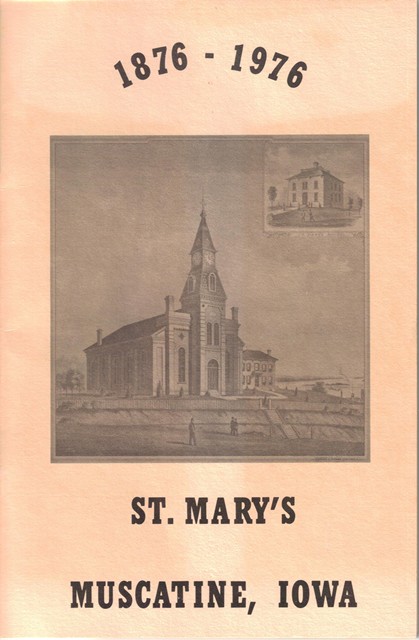
|
Transcribed by Sharon Elijah, February 23, 2015

|
“Go into the whole world and preach the gospel to every creature.” (Mark XVI, 15.) Situated on the western banks of the Mississippi River, part of the vastness of the Louisiana Purchase, in 1841 was a town known as Bloomington. In 1846 the State of Iowa was admitted to the United States of America and in 1849 Bloomington, Iowa became known as Muscatine, Iowa. The first permanent white settler of the State of Iowa in the year 1788 was Julien Dubuque, a French Canadian. From this origin grew our parish, known today as St. Mary’s of Muscatine, Iowa.
Father Samuel Mazzuchelli, the first Roman Catholic priest to celebrate Mass in Bloomington on January 25, 1841, wrote in his memoirs that there were ten persons of the Roman Catholic faith. It was held in the home of Mrs. Hannah McCrow located on Cedar Street near Second Street.
The Missionary considered that he would fulfill the most important part of his ministry toward those outside the Church by preaching in a large hall used as a schoolhouse by the village where all the ministers of the different sects were accustomed to preaching their doctrines. The text of his sermon was the reasons of wearing Catholic garb as opposed to Bible Ministers in secular clothing. This sermon served to win respect and reverence for the Catholics. Several times in 1841 and 1842 the Missionary preached in the town of Bloomington.
The zeal of the first Bishop of Dubuque, the Most Reverend Mathias Loras, led him to purchase a tract of land in the center of this flourishing village and in 1842 he ordered a frame building, 20 x 30 feet made in Prairie du Chien, Wisconsin and rafted down the Mississippi River. This building was the first Catholic Church for this city and it was erected on the lot purchased at 209 Cedar Street. This one story structure was dedicated to the Apostle Saint Mathias.
This congregation was served by missionary priests from Dubuque, Davenport and Iowa City until 1851 when the first resident priest was assigned. He was Rev. P. T. McCormick and only remained a few months. In November of the same year, the Rev. Phillip Laurent took charge of the congregation. During the year of 1852 additions were made to the structure forming an “L” shape. This was the priest’s living quarters and also the start of the first parochial school, which was taught in the Church by Miss Sarah Walther.
When the grading of Cedar Street took place, it caused the church to stand ten feet above the ground level, so a lower story was built at that time.
Page 2
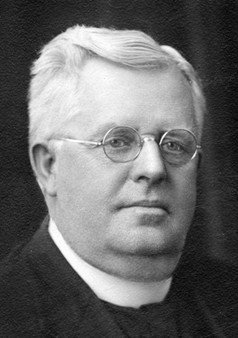 Rev. Frank Kottenstette 1927 - 1928 | 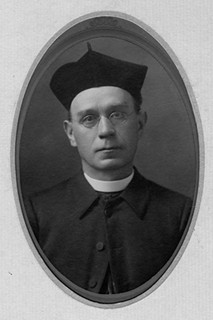 Rev. John I. Greiser 1879 - 1927 | 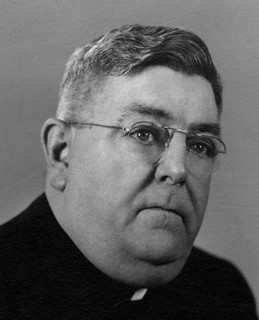 Rev. Jacob J. Schoenfelder 1928 - 1929 1949 - 1957 |
 Rt. Rev. Msgr Nicholas J. Peiffer, V. F. 1929 - 1941 | 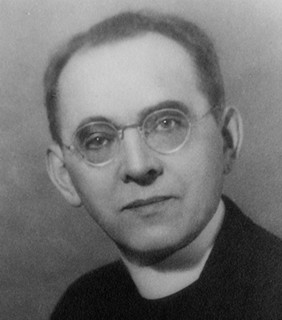 Rev. Henry M. Sendbuehler 1941 - 1949 | |
 Rev. Carl F. Clems 1958 - 1971 |  Rev. William O. Meyer 1971 - present (1976) |
Page 3
Father Laurent was given power by Bishop Loras in 1856 to sell this Church and to purchase one to meet the growing congregation needs. It was sold to the Turner Society and in 1860 it was converted to a German School building.
This original structure was donated back to the Catholics of Muscatine in the 1930’s and is now a museum of original artifacts and history of Catholics in the City. It is located on the grounds of St. Mathias Church.
The amount of $6,500, realized from the sale of the property, was used to purchase a block on Eighth Street between Pine and Chestnut Streets where a church was erected. The school attached to the Church was staffed in 1862 by nine Sisters of Charity of the Order of the Blessed Virgin. This is the site of the present St. Mathias Church.
Quoting from the History of Muscatine County, “The Germans were to the Irish as one is to three,” and so it was on January 18, 1863 the German Roman Catholic Church Society was organized. The Constitution of this Society states that the purpose was to obtain funds so that they could establish a German congregation of their own. Every German Roman Catholic family of the city was a member and could contribute no less than fifteen cents per month.
On May 17, 1863 a motion was made and seconded that a committee of four men; J. Kleinfelder, L. Arnold, George Wilmering and J. Fackeldey, make a report to the Bishop and explain the circumstances regarding their desire for a German Church.
It was through the working nucleus of this association that the first lot was purchased at Iowa Avenue and Sixth Street in late 1863, known as Lots 9 and 10. In 1864, owing to the uncertainty of the holding of the property in case of deaths, Rt. Rev. Smyth, Bishop of the Diocese, requested to take the deed in his own name and on December 1st he became owner in trust of the two lots.
It is recorded that the Building Committee of the German Roman Catholic Church Society on March 14, 1864 had $1,009.75 for payment of land, which cost $1,020.65, with a remaining debt of $10.90.
At the conclusion of a mission given March 19, 1867 by Father Damen, S.J., a meeting was held to consider the propriety of building at once. It was decided to start the grading of the lot in preparation to begin on March 30th. After a week of donated work by men and their horses Fr. Laurent returned from a sojourn to France and decided that this was not a suitable location for the German Church, being too close to the Irish Parish. So the Bishop ordered work stopped.
By 1872 the prospects of the Church being hemmed in between the City High School and the Turner Hall, it was decided to sell this site to the Muscatine School Board for $2,000. This sale was completed October 7, 1872.
Page 4
The following is a quotation from the condensed outline of the origin of St. Mary’s German Catholic Church, Muscatine, Iowa.
1874 A tract of land containing 5 acres, marked Lot 20, offered for sale by A. H. Shultz, of St. Louis, Mo., Franz J. Schaffer, who wants half of said lot, makes overtures with the Verein (German Society) and the Pastor (Rev. Laurent). He offers to let the Church have the east half of said lot 20 for $1,200. Shultz’ price for the whole lot is $2,000. Schaffer wants it for $1,200. Fearing lest the land may slip and be taken up by some other parties, Rev. P. Laurent secures it by paying the $2,000 and the deed is made and executed the 25th day of June, 1874 to the German American Roman Catholic Beneficial Society. Abstract of Title worth $10 donated by S. L. Wade through whom purchase was made. Green Street rectified by Act of City Council and the part of Lot 20 lying west of said street offered for sale at public auction. The sale of said half realizes the sum of $1,955, interest $50, being a gain of $55 for exchanging 120 x 140 feet of land for over two acres. George Schaffer, by permission, establishes a brick-yard on the place in order to bring down the hill.
All Catholics were invited from the altar on Sunday, April 14, 1875 to help grading the following week. So it is recorded that on Monday, April 5th, the actual grading for the new German Parish was started. Records show that grading continued into April of 1876.
The original church was plotted to face South on the lot, but Father Laurent, being of French descent, insisted that the Church face West. Permission was asked from Bishop Hennesey to lay the corner stone and go on with the building. The Bishop required a deed in his own name and a conditional deed was sent. The Bishop refused the deed and demanded a warranty deed, without conditions. In the meantime the building was commenced on the 21st of August and the ceremony of the corner stone was dispensed with. A dedication stone was laid above the main entrance at a later date. A deed was sent to the Bishop of 140 feet of the land, the Church occupying the center, and the Verein (Society) keeping possession of the remaining ground both north and south of the Church. Previously the Bishop had by quit claim, reconveyed the whole land to the Church in case of liens and financial commitments.
Page 5
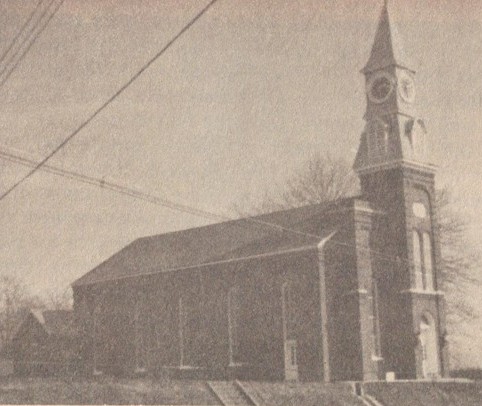
|
With persistent effort and hard work the German Catholics of the community completed their Church in the fall of 1877. John Knopp donated time as mason overseer and general boss. Many hours of strenuous work and financial assistance was donated to build this Church.
The next arduous task facing the German Roman Catholic Society was that of securing a priest. By late summer of 1878 they were getting desperate, having had their church ready for one year and no pastor. Letters of record dated August 8, August 19 and September 5, 1878 to Bishop Hennessey of Dubuque are records of their great desire to worship in their new church. A letter dated October 14, 1878 was taken personally by Franz Hartman to the Archbishop of St. Louis.
The next letter of record is dated December 4, 1878 to Bishop Hennessey of Dubuque thanking him for the assistance that soon a German priest would be arriving.
So it was with great joy that the news was received that Rev. John Ignatius Grieser, born in Donzdorf, Wurtenburg, Germany was appointed to be the first pastor. Fr. Grieser came to America in 1868. He began his studies for the priesthood in Germany, but completed at St. Francis Seminary, Milwaukee, Wisconsin. He was ordained by Bishop Hennessey in Dubuque on March 8, 1873. His first parish was Churchville, Iowa and from there to St. Joseph Church at Fort Madison where he was pastor for five years before coming to Muscatine.
The celebration of the first Mass was January 17, 1879. It was so bitter cold that Fr. Grieser froze the tips of his fingers. Snow had to be applied to them before he could proceed with the services. But the . . .
Page 6
. . . hearts of the members of St. Mary’s Parish were warm and vibrant in their prayers of thanksgiving and gratitude on the accomplishment of a long cherished desire. Mr. John Knopp, Sr. and Mr. Marten Havercamp took up the first collection. Matt Dell and Casper Weiss were the first altar boys and Mary Wilmering was the first organist.With the arrival of a pastor the work commenced on the completion of the interior of the church. The first ledger book shows entries dated January 22, 1879 for the purchase of four yards of 22 inch linen for altar cloth at 75 cents a yard; two china candlesticks at 75 cents each, 1 vase for ablution for 55 cents and one vase for baptizing at 15 cents. Other purchases were for church vestments, chalice, silk for tabernacle, artificial flowers, candles and holy oils besides purchases for lumber and nails for side altars, pews and wood burning pot-bellied stoves.
A dissension continued over who donated the most time, labor and monies to the building of St. Mary’s between the Irish and the Germans, causing Fr. Grieser to write a lengthy letter addressed to the “Voice of Truth,” in which he described the church as “100 feet long and 25 feet wide, resting on a stone foundation with brick walls 28 feet high and 1 ½ feet thick. The tower is 100 feet high and the windows are of baked stained glass and come from a factory in Chicago. The congregation membership is about 100 families and the church is valued at about $15,000 with a debt of $1,600.
The first 40-Hour Devotions were held by a Rev. P. Krieder in May of 1879.
On Sunday, October 26, 1879, the formal dedication of St. Mary’s Church took place at 10:30 a.m. It is recorded that the procession formed in the church and filed out the front door, over which hung a handsome horseshoe wreath of oak leaves. The procession included many visiting priests, boys in robes carrying banners and about thirty little girls in pink and blue sashes and wearing white wreaths on their heads and carrying baskets of flowers which they strewed as they walked. The procession marched slowly around the church while Fr. Laurent sprinkled holy water on the walls and grounds.
After the opening ceremony Rev. W. Jacoby of West Point preached in German. This was followed by Rev. P. Anselmus Mueller of Quincy who delivered a sermon in English. The Mass concluded the ceremony.
The original small pump organ at the Church was replaced on June 16, 1887 by the arrival of the two manual, 18 rank Pfeffer organ from St. Louis at a cost of $3,500. Within two months the organ was completely installed in the balcony of the church with the blowers in the tower. In order to play the organ a young man had to pump the organ by hand. Mary Wilmering continued to be the organist until November, 1888 when a Jas. Schaab from Germany was hired. A Prof. . . .
Page 7
 |
. . . Grade was hired in 1881 as instructor for a male choir and he continued for many years.Over the years the pipe organ has been updated; such as moving the blower inside the organ, replacing the hand-pump method with electricity. The pipe organ is still being used at church functions.
The church was built without the clock in the tower and without the bells. On April 10, 1889 the bells were purchased for $413.00 and installed. The clock with the striking chimes was purchased in 1905 after a series of lawn socials to raise money to pay for it. For many, many years the Angelus was rung by hand twice a day.
In the spring of 1879 a neat and comfortable building was erected on the South side of the church for the residence of Father Grieser. Evidently, the rectory was ready for occupancy by mid-August as the recording of house rent at $10.00 a month ceased to be shown. Many items are recorded as being purchased for the rectory during these months. The original rectory consisted basically of four rooms – two rooms on the first floor, a grand entrance hall and two rooms on second floor. The exposed basement housed the kitchen.
Miss Emilia Grieser, an older sister of Fr. Grieser’s joined him shortly after his arrival at St. Mary’s and kept house for him until her death in 1924.
In the year 1909 the rectory was expanded to the East to its present size, at which time the kitchen was moved to the first floor with the addition of a dining room and more bedrooms on the second floor. At this time a steam heating plant was placed in the basement of the rectory to heat the rectory and the church.
Page 8Records indicate the first water was from cisterns and wells with the first payment for water tax being made January, 1896. Other dates for utilities are as follows:
The first electricity payment was November, 1903.
During the year 1904 indoor plumbing and gas fixtures were added to the rectory.
The first telephone bill for $1.05 for service was Nov. 3, 1919.
A front porch to the rectory was added during the year of 1912.The formation of a new parish was a busy time, but the good parishioners under the direction of Fr. Grieser found time to start work on a four room brick schoolhouse during 1879 and on Dec. 14th of that year the first teaching nuns of the Order of St. Francis arrived to open the new school in January of 1880.
They bought the Hawley property for $2,900 and had a convent erected on it. All branches of the English education was taught in the school under the direction of the Franciscan Sisters. German was also taught. Soon the students from out-of-town were boarding at the convent and being instructed in their Faith preparing for First Communion and Confirmation. Many pupils came from neighboring towns of Wilton, Nichols, Riverside, Seventy-Six Township and even Cedar Rapids.
St. Mary's Convent
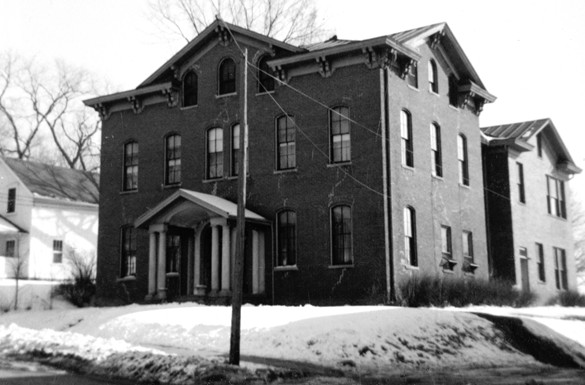
The old frame part of the convent building was torn down in 1927 and replaced with a brick addition. It had ceased to be used as a boarding school previous to this time.
Page 9
The convent remained the property of the Franciscan Sisters of Perpetual Adoration of LaCrosse, Wisconsin until 1955 when it was sold to St. Mary’s Church, but it remained a convent for the teaching nuns. At this time the name was changed from St. Joseph’s Convent to St. Mary’s Convent.St. Mary’s School was a fine brick structure erected in the late 1879 and 1880. It had four huge and spacious rooms for that time and lots of windows to let in the sunlight. Above the four classrooms was a parish hall. This parish hall was to be used for many years for various activities.
St. Mary's School

At first St. Mary’s school was an elementary, but soon expanded to include two years of high school. In 1925 an addition adjoining the school to the West was built and the four year high school graduated six students in 1926.
As the city, church and schools all continued a population growth, expansion became evident. An effort to consolidate St. Mary’s and St. Mathias High Schools was made during the year 1950. The Most Reverend Ralph L. Hayes, Bishop of Davenport, Rev. J. J. Schoenfelder, Pastor of St. Mary’s, Rev. J. J. Welsh, Pastor of St. Mathias and Rev. M. J. Dingman, Diocesan Superintendent of Schools and later the first Principal, were the key men in the consolidation.
In April, 1953 the school was officially incorporated under the title of Muscatine Catholic High School of Muscatine, Iowa. In 1955, the name of the school was changed to Hayes Catholic High School. This combined Catholic school was built at the West edge of Muscatine at 2407 Cedar St. at an approximate cost of $450,000. The first . . .
Pages 10 & 11View of St. Mary's, 1900
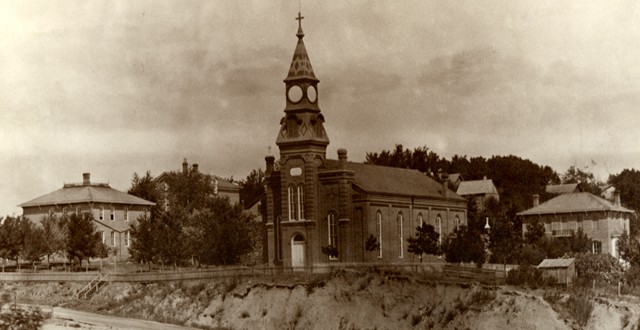 Page 12
Page 12
Hayes Elementery School, 1976
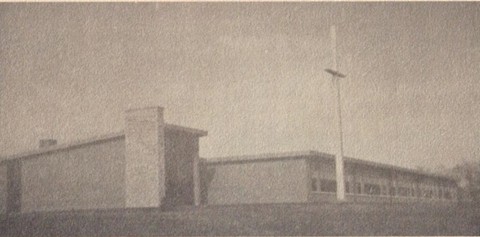 . . . graduating class from this new building was in 1956. Hayes Catholic High School was taught by both the Franciscan Order of Perpetual Adoration of LaCrosse, Wisconsin and the Sisters of Charity of the Blessed Virgin Mary of Dubuque.
. . . graduating class from this new building was in 1956. Hayes Catholic High School was taught by both the Franciscan Order of Perpetual Adoration of LaCrosse, Wisconsin and the Sisters of Charity of the Blessed Virgin Mary of Dubuque.Because of the spiraling costs of education and the necessity of replacing nuns with lay people the doors of St. Mary’s Grade School, St. Mathias Grade school, and Hayes Catholic High School were closed following the school year of 1968-69. In the fall the Hayes Building was occupied with a combined grade school of the two parishes of Muscatine with grades one through six.
The St. Mary’s School Building continued to serve the parish for Religious Education classes and to serve as a Church Hall. In the summer of 1972 the Church Council decided to have the old building demolished and use the space it occupied for an improved parking lot.
Page 13
MISSION – OUR LADY OF GUADALUPE Migrant farm workers from Texas had been coming to the Muscatine area to harvest the tomato crop since the middle 1950s. Rev. Carl Clems, pastor of St. Mary’s, joined an ecumenical group of lay people and local Protestant ministers to form the Muscatine Migrant Committee.
For many years St. Mary’s School was the focal point of the Day Care and Migrant Head Start program. Many Mexican-American migrant farm workers came to know and love Father Clems and call St. Mary’s their parish.
In the summer of 1966 three Sisters of the Order of Humility of Ottumwa, through the efforts of Father Clems, came to St. Mary’s and while residing at the St. Mary’s Convent brought many added pastoral services to the migrant farm worker. Working with the priests, Father Clems and Father Joseph Sparks, they visited the migrant labor camps, established Masses and invited the people to participate in the sacraments, arranging for Baptisms, counseling and religious education classes.
Bishop Gerald F. O’Keefe confirmed the first group of migrant farm worker children in 1967. Over the years many groups of Religious Sisters have sought to give their summer months in the work with migrant farm workers in the Muscatine area. Some of the Sisters are: the Sister of Humility, Dubuque Franciscans and LaCrosse Franciscans.
Sister Irene Monoz of the Order of Humility of Ottumwa came to Muscatine in 1967-68 to work all year with the Muscatine Migrant Committee as a registered nurse. Many of the migrant farm workers began to stay in the Muscatine community, seeking employment in the local industries.
Father Thomas Buechele was assigned by Bishop O’Keefe to St. Mary’s as an Associate Pastor in 1968 and to work in the Spanish Speaking Apostolate of the parish. Both Fr. Clems and Fr. Buechele served until 1970 and 1972 respectively, as members of the Muscatine Migrant Committee Board of Directors. By 1969 Fr. Vitolds Valanis of the St. Mathias Parish was also assigned to help service the total needs of the growing Mexican-American population.
Father Clems was assigned as Pastor of St. Mary’s Lone Tree, Iowa and Father William Meyer was assigned to St. Mary’s, Muscatine in 1971. In 1972 Father Buechele was sent by Bishop O’Keefe to Mexico to study more thoroughly the Spanish language and Mexican customs. Upon his return he was assigned full time as director of the newly formed Spanish Speaking Ministry supported by the parishes of the area, the Diocese of Davenport and the people themselves to which pastoral services were offered. The Spanish Speaking Ministry continued growing and soon was serving the people in Muscatine, West Liberty, Columbus Junction, Conesville and Burlington, Iowa.
Page 14
With the growing population and needs of the people both migrants and immigrants, Bishop Gerald O’Keefe in August of 1975 officially designated the Spanish Speaking Ministry as a Mission Church, which was dedicated to our Lady of Guadalupe on December 12, 1975. The Mission and Pastoral Team with Fr. Thomas Buechele, Vicar, Sister Molly Munoz, Brother Anton Torres and Fr. Gaston Retamal serves some 600 Catholic Spanish speaking families in Muscatine, Louisa and Des Moines Counties.
Page 15
ST. MARY’S CEMETERY In 1876 a society was organized under the name of “St. Mary’s Cemetery Association,” with a stock capital of $1,600.00. Its object, being the purchase of a suitable place for a new Catholic burying ground. The shares, $25.00 each, were soon taken up and a place was found, viz. outlots No. 11 and 12 and the North half of outlot No. 7, making 12 ½ acres. The road was graded from the Newell Road to the new cemetery, a culvert and bridge built, land was laid out in lots and streets, trees planted and lots were sold.
In August 1879 the St. Mary’s Cemetery Association sold 1 ½ acres of outlot No. 7, being the South 1 ½ acres of the North half of outlot No. 7, and purchased one acre of the adjoining outlot No. 8, in the one acre off of the North and of said outlot 8, and the Cemetery which before had the form of the letter “L,” became a parallelogram of 12 acres.
In November 1884 the St. Mary’s Cemetery Association by mutual consent and in accordance with their charter, made over the deed of the Cemetery to the Bishop of the Diocese and ceased to be a Society. (The above copied from the original Cemetery Record Book of St. Mary’s Parish.)
CLUBS AND SODALITIES Over the years many clubs and sodalities have organized and functioned for the spiritual and financial benefit of St. Mary’s. Some of which have been:
The original German Roman Catholic Beneficial Society which established and built the Church. Later this became known as the St. Joseph Society. The Sodality for Young Women and the Club for Young Men along with the Drama and Entertainment Club, which sponsored plays and entertainment, were active during the early years of the new church.
These were followed by the Sewing Society, Rosary Society, St. Agnes Society and Young Mens Sodality. Eventually the most active was the Altar and Rosary Sodality and for many years they supported the Church financially by sponsoring card parties, church dinners, quilting and many fund raising events.
The CATHOLIC DAUGHTER OF AMERICA, Court Joan of Arc No. 524 was chartered on June 20, 1920. There are seven living charter members of which Mrs. Mary Witteman is a parishioner of St. Mary’s. They have a current membership of 168 members. They support many worthwhile projects during the year. Meetings are the second Monday of every month at Hayes School. Barbara Brugger is Current Grant Regent.
Page 16
DCCW (Diocesan Council Catholic Women) was founded May 15, 1925 in Davenport, Iowa. At that time it operated under five Deaneries, but now it is under eleven Districts of our Diocese. It is a federation of all Catholic woman’s organizations that enjoy Episcopal approval in the Diocese. They channel information in the field of Catholic action for the study and action promoted by the commissions through an organization structure to every woman in the Diocese, so that they can be alert and sensitive to the needs of the Church, the Community and the World and for their fulfillment as Christians.
KNIGHTS OF COLUMBUS Laurent Council No. 1305 received its Charter in 1908. The Council was named Laurent for the French Priest Phillip Laurent, who was the first resident priest in Muscatine.
Eighty-seven candidates were initiated in the First Degree. Art Begey, a member of St. Mary’s Church, is the only living Charter member.
The building now owned by the Labor Unions was purchased by the Knights from the J. E. T. Wessel Estate July 2, 1928. This became the first permanent home, as prior to this time their meetings were held in other halls.
October 26, 1945 the Knights purchased the KTNT Norman Baker Radio site up on the hill overlooking the Mississippi River. They held all of their functions there until the property was condemned by the State of Iowa for fill for the approach to the new bridge. This was in April of 1971.
A five-acre site was purchased on Houser Street in November, 1973 and after much remodeling the Knights have a new home.
Present membership is 126 (in 1976). Willard Last is Grand Knight and Daniel Anson is Deputy Grand Knight.
Page 17
PARISH COUNCIL Bishop Gerald O’Keefe issued a directive during 1968 for each parish to organize a Parish Council. Under Fr. Clems guidance St. Mary’s Council was formed and held the first meeting on July 22, 1968. This Council has been very effective in assisting the Pastor through the functions of the various committees: Finance, Christian Service, Liturgy, Family Life, Building and Grounds, Parish Activities, Education and Youth, Long Range Planning and Bingo. The first president was Leonard Aull and the current president is Theodore Blaesing.
MUSCATINE CATHOLIC BOARD OF EDUCATION The Muscatine Catholic Board of Education was formed in 1967. It is composed of three lay representatives from each Parish and the two Pastors. The Administrator of the School and the Religious Education Co-ordinator are ex officio members. One member from each Parish is elected each year to serve a three year term. The purpose of this Board is to assist in the governing and financial structure of the school and religious education classes. The current president is Donald Fennell.
ASSOCIATE PASTORS TO ST. MARY’S CHURCH
Rev. Paul S. Kleinfelder 1919-1921 Rev. J. A. Wagner 1926-1926 Rev. Paul C. Wetzstein 1931-1932 Rev. Leo V. Kuebrich 1932-1938 Rev. Charles D. Mannhardt 1938-1942 Rev. Maurice J. Dingman 1942-1942 Rev. Raymond J. Pacha 1942-1948 Rev. George E. Snell 1948-1955 Rev. Donald L. Waldschmidt 1955-1965 Rev. Marvin N. Sieger 1965-1966 Rev. Joseph R. Sparks 1966-1968 Rev. Thomas J. Buechele 1968-1972 Page 18
BISHOPS OF THE DIOCESE
Most Rev. Mathias Loras – Bishop of Dubuque Most Rev. Clement Smyth – Bishop of Dubuque Most Rev. John McMullen – Bishop of Davenport 1881-1883 Most Rev. Henry Cosgrove – Bishop of Davenport 1884-1906 Most Rev. Janes Davis – Bishop of Davenport 1906-1926 Most Rev. Henry P. Rohlmann – Bishop of Davenport 1927-1944 Most Rev. Ralph L. Hayes – Bishop of Davenport 1944-1966 Most Rev. Gerald F. O’Keefe – Bishop of Davenport 1966-present (1976) PRIESTS FROM THIS PARISH
Rev. Henry c. Takkenberg, ordained Rome April 20, 1913. Died Feb. 5, 1936, taught at School of Religion, Univ. of Iowa. Rev. Paul S.. Kleinfelder, ordained August 24, 1919. Died December 18, 1962. Rev. Albert R. Goetzman, ordained Rome October 24, 1931. Pastor of St. John’s Church, Houghton, Iowa. Brother Herman Nester, entered Alexian Brothers, Chicago as Novitiate July, 1915. Died five years later in their Oshkosh, Wisconsin Hospital. VOCATIONS OF NUNS FROM ST. MARY’S PARISH AND SCHOOL
Sister Mary Coletta, F.S.P.S., 1881 – Mattern Family Sister Mary Rosalia, F.S.P.A., 1883 – Theresa Nester Sister May Alexandra, F. S. P. A., 1889 – Mattern Family Sister Mary Silveria, F. S. P. A., 1890 – Emma Goetzman Sister Mary Ermalinda, F. S. P. A., 1909 – Josephine Mary Schrempf Sister Mary Alonza, F. S. P. A., 1917 – Francis Bielefeld Sister Mary Agneu, B. V. M., 1920 – Agnes Nester Sister Mary Felicitas, F. S. P. A., 1920 – Rosalia Nester Sister Mary Artemas, B. V. M., 1931 – Maybelle Kurriger Sister Mary Leona, F. S. P. A., 1933 – Leona Brugman Sister Mary Josara, F. S. P. A., 1936 – Pauline Bielefeld Page 19
St. Mary's Church Interier, 1960's
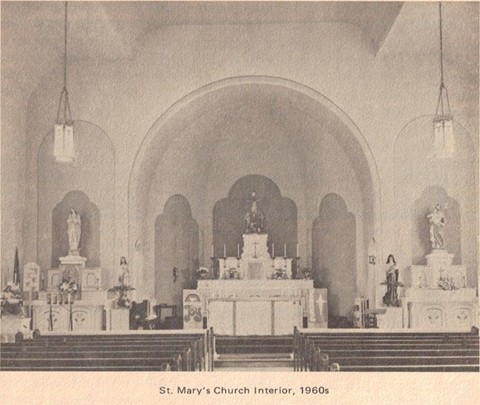
St. Mary’s Centennial Year 1976 with a membership of over 500 families. This booklet written by Mrs. Mary M. Blaesing is one of the many projects and events associated with the centennial celebration of St. Mary’s Parish.
Page 20
“May God bless all the donors and give them an everlasting reward in heaven.”
Rev. John I. Grieser
First PastorO God, our Heavenly Father,
We thank you for all the graces and helps you have given our parish in the past. We appreciate the sacrifices of our ancestors. They have given us a great heritage of faith, love courage and zeal.
May we continue that heritage, under the patronage of Mary, our Heavenly Mother. In so doing, may our whole parish family arrive in our heavenly home and share in that Eternal Reunion with you, who lives and reigns forever and ever. Amen.
Rev. William O. Meyer
Present Pastor (1976)* ~ * ~ * ~ * ~ * ~ * ~ * The darker black and white pictures were provided from actual photographs provided by the Musser Public Library. For copies of these photographs contact Musser Public Library at refmus@muscatineiowa.gov
* ~ * ~ * ~ * ~ * ~ * ~ * Back to Muscatine Co. IAGenWeb, Index Page
Page created March 1, 2015 by Lynn McCleary